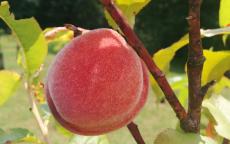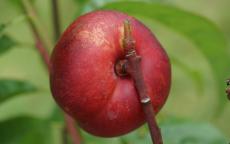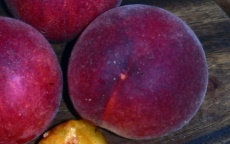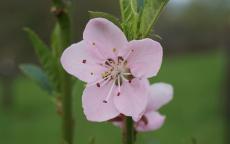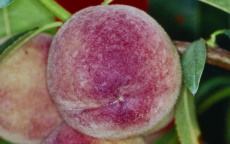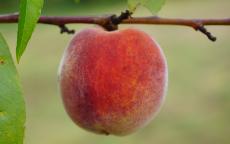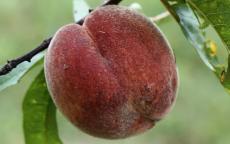Peach trees
Peaches are a luxurious fruit originating in the Far East and now grown throughout warm temperate regions. Peach trees prefer a continental climate, especially warm or hot summers.
Peach trees can be grown successfully in the UK. However if you want to be reasonably sure of success the best method is to grow as a fan on a south-facing wall, or in a patio container which can be moved indoors (to an unheated room or conservatory) during winter, or - ideally - under permanent cover in a greenhouse or polytunnel.
Peach-leaf curl is a serious fungal disease of peaches (and nectarines). It is transmitted by fungal spores which are active during late-winter / early-spring and are carried in splashes of rain drops. The infection causes the leaves to curl and shrivel (often taking on a dull red tinge at the same time). Although the tree will often produce a second flush of leaves later in the spring, it will probably not produce any fruit. Fortunately peach leaf curl can be readily avoided by covering wall-trained trees over winter and early spring with a frost fleece or similar.
Peach trees grown in patio containers can also be protected simply by keeping them indoors over the winter. If you are growing your peach trees in a greenhouse or polytunnel then you will be able to avoid it altogether.
Fungal and bacterial infections in peaches are often the result of over-watering, particularly if the tree is in a greenhouse where airflow might be restricted.
All peaches are self-fertile - but that doesn't mean they don't need pollinating, it just means you don't need another peach tree nearby to cross-pollinate with. Pollen must still be taken from one flower to the other and since peaches flower very early in the season you can't always rely on pollinating insects to be out and about. If in doubt, you can hand-pollinate - here's an article on the my tiny plot blog showing you how.
Whilst it is generally advisable to keep pruning of all stone fruit to a minimum, and if possible only prune in early spring, nevertheless regular pruning is quite important with peaches. The main objective is to remove older wood and leave younger shoots - this is because peaches (and nectarines) fruit primarily on 1-year shoots (i.e. the shoots which grew the previous summer).
If your peach tree sets a good crop in the spring then it is important to thin the fruitlets, otherwise you will end up with lots of small peaches with little flavour. It is worth being ruthless with the thinning because the flavour of home-grown peaches eaten straight from the tree is worth a bit of work!
Amsden June
An early-ripening white-fleshed freestone peach from the USA, ready in June / July in the UK.- Picking season: Very early
- Self-fertility: Self-fertile
- Flesh colour: White
Avalon Pride
A disease-resistant yellow-fleshed peach, well-suited to growing outdoors in the UK.- Picking season: Mid
- Self-fertility: Self-fertile
- Flesh colour: Golden / Yellow
Bellegarde
A well-regarded late-season traditional yellow-flesh peach.- Picking season: Late
- Self-fertility: Partially self-fertile
- Flesh colour: Golden / Yellow
Bonanza
Bonanza is a dwarf self-fertile peach, featuring large yellow flesh peaches. An ideal peach tree for a patio planter.- Picking season: Mid
- Self-fertility: Self-fertile
- Flesh colour: Golden / Yellow
Garden Lady
Garden Lady is a slow-growing dwarf peach variety, ideal for pot culture.- Picking season: Early
- Self-fertility: Self-fertile
- Flesh colour: Golden / Yellow
Gorgeous
Gorgeous is a yellow-fleshed peach, well adapted to the English climate.- Picking season: Mid
- Self-fertility: Self-fertile
- Flesh colour: Golden / Yellow
Hale's Early
Hale's Early is an early-season American peach variety, but with a good track record of being productive in the UK climate.- Picking season: Early
- Self-fertility: Self-fertile
- Flesh colour: Golden / Yellow
Rochester
An excellent yellow-fleshed peach, well-suited to the UK climate.- Picking season: Mid
- Self-fertility: Self-fertile
- Flesh colour: Golden / Yellow
- Awards: RHS AGM (former)

